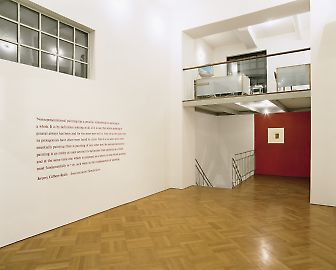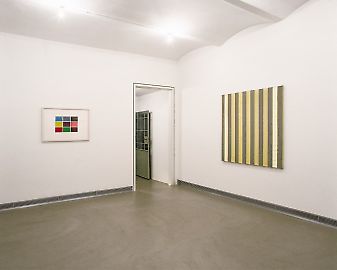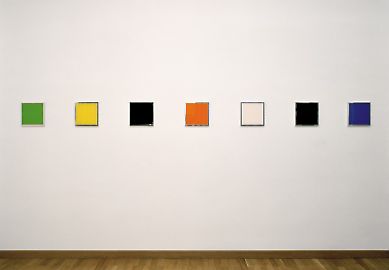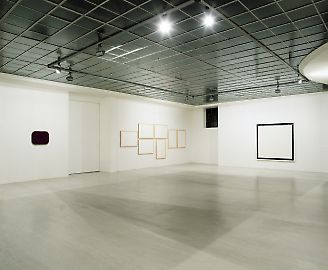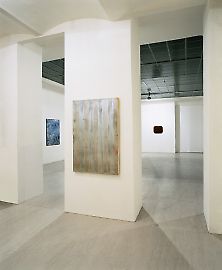Weg aus dem Bild --
Richard Artschwager, Jo Baer, Herbert Brandl, Daniel Buren, Franz Graf, Herbert Hinteregger, Sherrie Levine, Inés Lombardi, Raymond Pettibon, Stephan Prina, Arnulf Rainer, Gerhard Richter, Gerwald Rockenschaub, Robert Smithson, Rudolf Stingel, Esther Stocker, Elaine Sturtevant, Heimo Zobernig
Georg Kargl’s offer to hold an exhibition using works from his collection with a few supplementary works was not such an easy task, to the extent that the collection’s heterogeneity bears the danger of a certain arbitrariness of selection. At the same time, being forced to work with a given set of artworks and produce a meaningful whole presents the opportunity of arriving at new ways of looking at things. This is especially true of Kargl since he does not limit his collecting to certain programs or eras, but simply ventures into the most various terrains with his own standards of quality. One issue that resulted from this was a limitation to the medium of painting, secondly the non-figurative in its various forms and various motivations. Since in chronological terms Pop Art and minimalism marked the beginning of the works shown, it was clear that the issue of the non-figurative moves beyond a linear history of abstraction beginning with mimetic representation and ending with the monochromatic picture. The non-figurative itself has become historical, so to speak, and cannot be seen as being motivated by abstraction alone. In this sense, the non-figurative cancels itself out as an issue, for it always points outside itself, to other conditions and motives that bring it to the picture. Seen in this way, the paintings by Robert Smithson form a starting point for the exhibition: painted at a time when modernist abstraction had gotten caught up in its ultimate crisis, the paintings of lightning bolts predate Smithson’s well-known minimalist pieces, resonating more with Pop Art. But their strength lies precisely in the way that they represent an attempt to rescue painting doomed to failure from the start, pointing to the artist’s later projects. Similar here are paintings of the still undervalued Jo Baer, whose empty monochromatic fields in the center of canvas ironically symptomatize the abandonment of the medium. In works like those of Sherry Levine or Elaine Sturtevant, it is quotation that inscribes modernist abstraction into a historical past. A different critical relationship to the modern picture can be found in the work of Rudolf Stingel, whose monochromatic works quite concretely lead out of the picture into the space surround it and the work’s installation. In younger artists like Gerwald Rockenschaub or Heimo Zobernig, the formal language of modernism in its historical anchor has already become everyday, and thus part of a non-artistic world of perception, so that it, in an almost mimetic way, can again be returned to the picture. Rockenschaub’s geometric objects and Zobernig’s writing become picture, show this in their own specific ways. Herbert Hinteregger’s monochromatic works can in this context also be read as confronting the problem of the immateriality of the discourse of modernist painting: on closer inspection, the ballpen ink produces a materiality that almost makes the image into a sculptural object. The non-figurative from a conceptual view is presented in the work by Inés Lombardi, while Esther Stocker’s works treat the nonfigurative as the perceptual precondition for figurative perception. Seen retrospectively, this suggests that there are various motivations for a language beyond mimetic form; that many ways lead to the pictures of this exhibition.
Martin Prinzhorn, "Wasserstrasse statt Datenhighway," in: Parnass, 3/2002, p. 99


